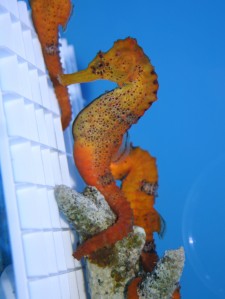Seahorses have long been one of the icons of the aquarium hobby, with graceful movements and a delicate, unusual appearance. Seahorses are members of a family of fish known as Sygnathids, meaning “spiny-finned fish”. Other members of the family include Sea Dragons and Pipefish. They each have a small tubular  snout that enables them to suck in prey items like brine shrimp, copepods, and other similar crustaceans. Seahorses and their relatives are timid and slow-moving. They are most often found in beds or sea grass where they can use their tails to anchor themselves to the grass or corals and not be carried off by the current. Seahorses bear live young that are carried in a pouch, similar to a Kangaroo, until they are mature enough to be released.
snout that enables them to suck in prey items like brine shrimp, copepods, and other similar crustaceans. Seahorses and their relatives are timid and slow-moving. They are most often found in beds or sea grass where they can use their tails to anchor themselves to the grass or corals and not be carried off by the current. Seahorses bear live young that are carried in a pouch, similar to a Kangaroo, until they are mature enough to be released.
A couple of years ago, seahorses were a rather common offering in Aquarium Stores nationwide. Seahorses have long been one of the icons of the aquarium hobby, with graceful movements and a delicate, unusual appearance. In recent years, the with the technical advancements in aquarium keeping, environments can be created to more easily and better suited to keeping these amazing fish. The possibility of keeping sea horses is more within reach than ever. But where have they gone?
In 2004, the Convention on International Trade in Endangered Species (CITES) upgraded the status of Seahorse species to “vulnerable” meaning that the seahorse populations are in danger of a 30% decrease due to targeted catch, accidental capture, and habitat loss. One of the biggest threats to these species is the high demand for their dried bodies in Asian and Southeast Asian medicine trades. Climate changes and habitat destruction are also taking huge tolls on these interesting and amazing little creatures.
With growing awareness and increased conservation efforts, captive breeding programs for these animals are growing in number and are becoming increasingly successful. If you’re lucky enough to venture into keeping them in a home aquarium, strive to purchase captive raised individuals. By doing so, stress on wild populations can be reduced, and these animals tend to adapt to aquarium conditions and diets with more ease than wild-caught specimens. Be sure to check out the related articles in the blog for more fascinating facts and tips on keeping these guys at home.
Thanks, Eileen
 That Fish Blog – Aquarium Advice and Information
That Fish Blog – Aquarium Advice and Information

